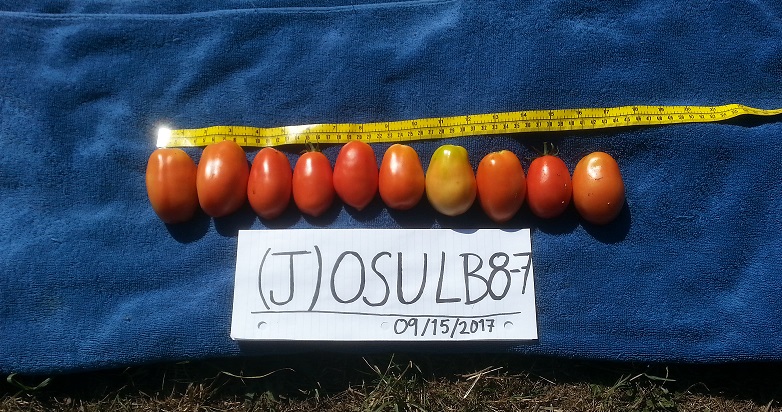This determinate, red, plum type tomato is an experimental hybrid from Oregon State University bred for late blight resistance. It has a complicated pedigree including an old variety (Legend), a different OSU breeding line, a former Cornell breeding line, and an accession of Solanum habrochaites. This background is reportedly a rich source of late blight resistance genes. Legend contributes the now obsolete Ph1, the OSU line provides Ph2, the Cornell line includes Ph3, and the S. habrochaites would contribute quantitative resistance when introgressed into the tomato genome. For more information on these genes, check out my spring quarter work on late blight and resistance in tomato.
Truthfully, I wish I had better things to say about this breeding line. OSU LB8-7 has consistently been one of the most disease susceptible up until this point. Plants have tolerated disease okay in that they are still producing a fair amount of fruit, but the plants are spindly and droopy in the field. They have pretty dense, flat-leaved foliage too, which is only helping to hold in humidity and encourage fungal problems. The fruit themselves are small, and at one point described as “funky.” Perhaps because it was the last to ripen, OSU LB8-7 was also the only variety that showed blossom end rot, a sign of calcium deficiency that can also be exacerbated by insufficient magnesium levels. What this means cannot conclusively be stated. Possibilities might include higher needs/thresholds for these nutrients, less competitive abilities to obtain these nutrients from soil, low soil nutrient levels, etc.
OSU LB8-7 was also not well received when eaten fresh, receiving many 1s from tasters. By far, the biggest consumer complaint was the thick skin, which one participant described as “like leather.” This is certainly disappointing, but it’s important to remind ourselves that plum tomatoes are meant more for processing. A thick skin may actually be advantageous in peeling this variety prior to making sauce. As I’ve mentioned before, the three plum varieties are going through a slow roast process in my oven for a tasting next week. OSU LB8-7 produced the most intense and intoxicating aroma going through this process. My house smelled of nutty, Parmesan cheese for hours while these slowly dried at 200 degrees F. There’s got to be something redeemable in that fact, no?
First Ripe Fruit:
| Block 1 | Block 2 | Block 3 |
| August 22 | August 25 | August 25 |
All harvest data represents two OSU LB8-7 plants from each block, or six plants total:
Harvest 1 (September 8, 2017)
Picking Ease (5=easy, 1=difficult): 4
Marketable Fruit: 40 fruit weighing 2368g (5.22 lb.) Unmarketable Fruit: 21 fruit weighing 734g (1.62 lb.)
Reasons why unmarketable: too small, blossom end rot, splitting
Harvest 2 (September 15, 2017)
Picking Ease (5=easy, 1=difficult): 4
Marketable Fruit: 35 fruit weighing 1962g (4.33 lb.) Unmarketable Fruit: 16 fruit weighing 548g (1.21 lb.)
Reasons why unmarketable: too small, blossom end rot, scabbing
Average Fruit Size: 4.51 cm x 6.59 cm (1.76″ x 2.59″)
Brix: 6.7, 7, 9.1
Harvest 3 (September 22, 2017)
Picking Ease (5=easy, 1=difficult): 3
Marketable Fruit: 30 fruit weighing 1757g (3.87 lb.) Unmarketable Fruit: 11 fruit weighing 429g (15.13 oz.)
Reasons why unmarketable: too small
Harvest 4 (September 29, 2017)
Picking Ease (5=easy, 1=difficult): 4
Marketable Fruit: 24 fruit weighing 1385g (3.05 lb.) Unmarketable Fruit: 19 fruit weighing 616g (1.36 lb.)
Reasons why unmarketable: too small, fruit rot
Harvest 5 (October 6, 2017)
Picking Ease (5=easy, 1=difficult): 4
Marketable Fruit: 21 fruit weighing 1265g (2.79 lb.) Unmarketable Fruit: 14 fruit weighing 484g (1.07 lb.)
Reasons why unmarketable: too small, fruit rot, splitting

Leave a Reply